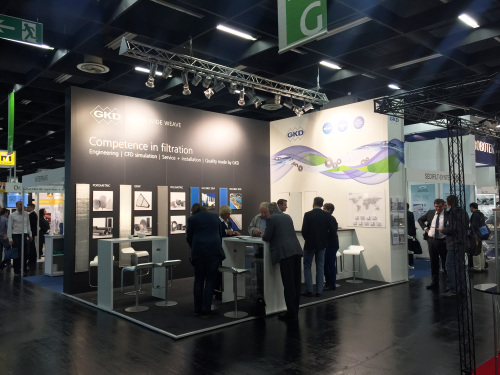
At the FILTECH exhibition and conference visitors to the GKD stand were shown the company’s three-dimensional Porometric mesh, flow-optimised mesh type OT6 and a procedure for the simulation of the bubble point test.
Three-dimensional porometric mesh
Based on the findings of a study conducted jointly with the Texan energy concern ConocoPhillips into the erosion behaviour of filter media in well pipes, GKD has developed a three-dimensional porometric mesh type with rectangular pores. Compared with conventional constructions, this development, based on the YMAX product range, has a lower weight of the weave, which has been achieved through modification of its construction and so should give lower costs.
The company claims that the higher porosity of the multi-layered mesh construction reduces local pore velocity by up to 40%, compared to the performance of standard twilled or plain dutch weaves currently available on the market, while maintaining a constant volume flow rate. This means that the throughput increases by a similar factor. Particles above the required cut point are quickly separated, while at the same time the special mesh structure aims to ensure extremely high dirt-holding capacity.
Flow-optimised mesh type OT6
In order to meet the finest separation rates, this mesh construction combines a geometric pore size of just 6 µm with a high throughput rate, a low tendency to clog, and optimal backwashing capability. Since GKD achieves the requisite pore size through its weaving process, and not through finishing stages like calendaring, a consistently high degree of porosity is the target. The rectangular, slot-shaped pores on the surface of the mesh, which are smaller than the pores in the interior of the mesh, allows particles above the required cut point to be separated on the mesh surface. Smaller particles pass freely through the larger inner pores, so preventing any clogging of the media. This special pore geometry also explains the combination of high dirt-holding capacity and very low flow resistance of the OT6 mesh.
Simulation of the bubble point test
GKD's in-house development of a procedure for the numerical simulation of the bubble point test drew much attention. Up until now, time-consuming screenings were required for the determination of the maximum pore diameter. For GKD, these are now a thing of the past. Through the numerical simulation of the bubble point test and the reliable capillary pressure constants determined from the simulation, GKD has now found a procedure with which the maximum pore size for all standard woven meshes can precisely calculated in a matter of seconds; this includes optimised dutch weaves, twilled dutch weaves and reverse dutch weaves. Whether for quality control during production runs, application-specific optimisation or the development of new mesh types, with its numerical simulation of the bubble point test GKD is a major player in the production of high-precision industrial meshes.
Follow-up projects
The company has a number of planned follow-up projects. For example, the company is currently working on the development of finer and coarser pore sizes of the three-dimensional mesh type Porometric, which has already proved itself with a pore size of 150 µm.
